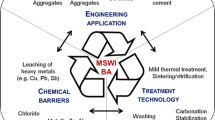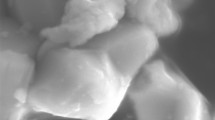Abstract
Construction and demolition waste (C&D waste) recycled and reused as the substitution of construction material is a promising method for C&D waste treatment and management. To broaden the application possibility under different temperature conditions and improve waste consumption, the effects of temperature and additives on the recycled coating performance were investigated in this study. Choosing scrubbing resistance as the performance evaluation index, the recycled waterborne coating exhibited relatively outstanding scrubbing resistance when emulsion Tg was between 22.3 and 30.5 °C around the ambient temperature. This further implied that the application of an appropriate Tg according to the painting temperature could result in achieving the desired coating. The film-forming additives tests for the recycled brick powder waterborne coating system were found to be effective in improving the coating’s performance, with ranking: alcohol ester dodecyl > propylene glycol > glycol, due to the MFFT reduction. For the adding mode perspective, the mixed-additives treatment (over 7% addition) displayed more effective than single-additive treatment, achieving a twofold increase in coating performance at 35 °C and a fourfold to sixfold increase at 40 °C. The film-forming additives, particularly the mixed-additives treatment, not only broaden the application temperature range at low temperatures, but also strengthen the coating’s performance at high temperatures.




Similar content being viewed by others
References
Ilcan H, Sahin O, Kul A et al (2022) Rheological properties and compressive strength of construction and demolition waste-based geopolymer mortars for 3D-printing. Construct Build Mater 328:127114. https://doi.org/10.1016/j.conbuildmat.2022.127114
Jike N, Xu C, Yang R et al (2022) Pervious concrete with secondarily recycled low-quality brick-concrete demolition residue: engineering performances, multi-scale/phase structure and sustainability. J Clean Prod 341:130929. https://doi.org/10.1016/j.jclepro.2022.130929
Brandao R, Edwards DJ, Melo ACS et al (2023) Reverse supply chain practices for construction and demolition waste in the Brazilian Amazon: a multi-stakeholder view. J Mater Cycles Waste Manag 25:2245–2261. https://doi.org/10.1007/s10163-023-01680-1
Bao Z, Lu W (2020) Developing efficient circularity for construction and demolition waste management in fast emerging economies: lessons learned from Shenzhen, China. Sci Total Environ 724:138264. https://doi.org/10.1016/j.scitotenv.2020.13826
Chen J, Su Y, Si H et al (2018) Managerial areas of construction and demolition waste: a scientometric review, vol 15. Multidisciplinary Digital Publishing Institute, Basel, p 2350. https://doi.org/10.3390/ijerph15112350
Devaki H, Shanmugapriya S (2023) Investigating barriers to sustainable management of construction and demolition waste: the case of India. J Mater Cycles Waste Manag 25:1594–1607. https://doi.org/10.1007/s10163-023-01631-w
Li JR, Yao Y, Zuo J et al (2020) Key policies to the development of construction and demolition waste recycling industry in China. Waste Manag 108:137–143. https://doi.org/10.1016/j.wasman.2020.04.016
Li J, Zuo J, Guo H et al (2018) Willingness to pay for higher construction waste landfill charge: a comparative study in Shenzhen and Qingdao, China. Waste Manag 81:226–233. https://doi.org/10.1016/j.wasman.2018.09.043
Song Q, Li J, Zeng X (2015) Minimizing the increasing solid waste through zero waste strategy. J Clean Prod 104:199–210. https://doi.org/10.1016/j.jclepro.2014.08.027
Mahakud J, Mishra SP, Mohanty RC et al (2021) Management of construction and demolished waste as an aggregate substitute in cement concrete. Int J Environ Clim Change 11(5):122–137. https://doi.org/10.9734/IJECC/2021/v11i530415
Robalo K, Costa H, do Carmo R et al (2020) Experimental development of low cement content and recycled construction and demolition waste aggregates concrete. Construct Build Mater 273:121680. https://doi.org/10.1016/j.conbuildmat.2020.121680
Robinson GR, Menzie WD, Hyun H (2004) Recycling of construction debris as aggregate in the Mid-Atlantic Region, USA. Resour Conserv Recycl 42(3):275–294. https://doi.org/10.1016/j.resconrec.2004.04.006
Li H, Dong L, Jiang Z et al (2016) Study on utilization of red brick waste powder in the production of cement-based red decorative plaster for walls. J Clean Prod 133:1017–1026. https://doi.org/10.1016/j.jclepro.2016.05.149
Das SK, Shrivastava S (2022) Durability analysis and optimization of a binary system of waste cement concrete and glass-based geopolymer mortar. J Mater Cycles Waste Manag 24:1281–1294. https://doi.org/10.1007/s10163-022-01400-1
Zheng Y, Zhao YC, Bai JS et al (2019) Suspension stability of waterborne coating slurry prepared using construction and demolition waste. Construct Build Mater 207:41–47. https://doi.org/10.1016/j.conbuildmat.2018.12.108
Chen B, Zheng Y, Zhao YC et al (2023) Recycled brick powder from construction and demolition waste as waterborne coating filler with robust scrubbing resistance. Construct Build Mater 385:131494. https://doi.org/10.1016/j.conbuildmat.2023.131494
Toussaint T, De Wilde M, Molenaar F et al (1997) Calculation of Tg and MFFT depression due to added coalescing agents. Progr Organ Coat 30(3):179–184. https://doi.org/10.1016/S0300-9440(96)00685-6
Ou YX, Wang HQ, Ouyang X et al (2023) Recent advances and strategies for high-performance coatings. Progr Mater Sci 136:101125. https://doi.org/10.1016/j.pmatsci.2023.101125
Chen W, Wu ZW, Xie YX et al (2023) Fabrication of silane and nano-silica composite modified bio-based WPU and its interfacial bonding mechanism with cementitious materials. Construct Build Mater 371:130819. https://doi.org/10.1016/j.conbuildmat.2023.130819
Huang X, Wang S, Wu Y et al (2021) Preparation and characterization of high-strength and water-resistant waterborne epoxy resin/magnesium oxychloride composite based on cross-linked network structure. Construct Build Mater 285:122902. https://doi.org/10.1016/j.conbuildmat.2021.122902
Lv X, Wang K, He Y et al (2019) A green drying powder inorganic coating based on geopolymer technology. Construct Build Mater 214:441–448. https://doi.org/10.1016/j.conbuildmat.2019.04.163
Zhang T, Liao H, Huang W et al (2023) High temperature steam oxidation behavior of textured Cr coatings with different grain structures. Surf Coat Technol 459:129358. https://doi.org/10.1016/j.surfcoat.2023.129358
GB/T 9266–2009. Determination of scrub resistance of film of architectural paints and coatings[S]. China
GB/T 1730–2007. Paints and varnishes-Pendulum damping test[S]. China
GB/T 1720–2020. Circle-drawing test of coating films[S]. China
HG/T 334–2012. Water absorption Determination of water absorption of paint film[S]. China
Maltanava HM, Vorobyova TN, Vrublevskaya ON (2014) Electrodeposition of tin coatings from ethylene glycol and propylene glycol electrolytes. Surf Coat Technol 254:388–397. https://doi.org/10.1016/j.surfcoat.2014.06.049
Li CX (2008) Volatilization of mono- or multi-film forming additive from the film of water-borne coatings. China Coat 23(9):20–23. https://doi.org/10.13531/j.cnki.china.coatings.2008.09.006. (in Chinese)
Rohmihaas (China) Investment Company Limited (2007) Selection of film forming additives in the application of high Tg emulsions. In: Proceedings of the first Workshop on the Development of Waterborne Wood Coatings by China Coating Industry Association, pp 206–209. (in Chinese)
Acknowledgements
This work was supported by the National Natural Science Foundation of China (Grant No. 51979079).
Author information
Authors and Affiliations
Contributions
Methodology and writing—original draft were performed by Bo Chen and Tao Zhou. Investigation and analysis were performed by Yan Wang and Yi Zheng. Conceptualization, writing—review, and editing and supervision were performed by Longxi Han and Youcai Zhao. All authors read and approved the final manuscript.
Corresponding author
Ethics declarations
Conflict of interest
The authors declare that they have no known competing financial interests or personal relationships that could have appeared to influence the work reported in this paper.
Additional information
Publisher's Note
Springer Nature remains neutral with regard to jurisdictional claims in published maps and institutional affiliations.
Rights and permissions
Springer Nature or its licensor (e.g. a society or other partner) holds exclusive rights to this article under a publishing agreement with the author(s) or other rightsholder(s); author self-archiving of the accepted manuscript version of this article is solely governed by the terms of such publishing agreement and applicable law.
About this article
Cite this article
Chen, B., Wang, Y., Zheng, Y. et al. Effect of temperature and additives on recycled waterborne coating preparation and performance for construction and demolition waste reutilization. J Mater Cycles Waste Manag 26, 1667–1675 (2024). https://doi.org/10.1007/s10163-024-01924-8
Received:
Accepted:
Published:
Issue Date:
DOI: https://doi.org/10.1007/s10163-024-01924-8




